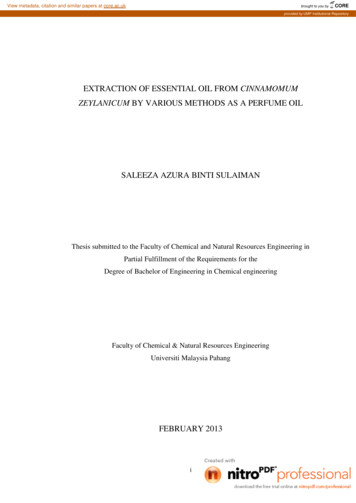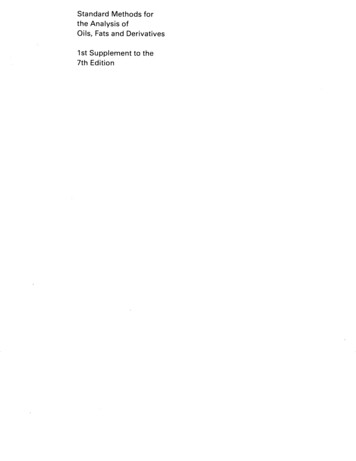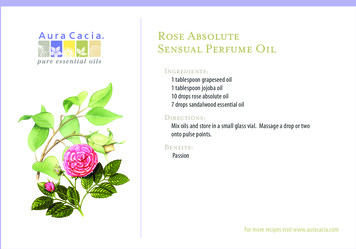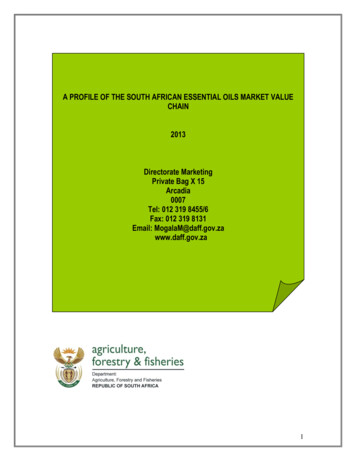
Transcription
View metadata, citation and similar papers at core.ac.ukbrought to you byCOREprovided by UMP Institutional RepositoryEXTRACTION OF ESSENTIAL OIL FROM CINNAMOMUMZEYLANICUM BY VARIOUS METHODS AS A PERFUME OILSALEEZA AZURA BINTI SULAIMANThesis submitted to the Faculty of Chemical and Natural Resources Engineering inPartial Fulfillment of the Requirements for theDegree of Bachelor of Engineering in Chemical engineeringFaculty of Chemical & Natural Resources EngineeringUniversiti Malaysia PahangFEBRUARY 2013i
ABSTRACTCinnamomum Zeylanicum is a very popular spice and very useful substances inmedicines and food, said to be originated from the island Sri Lanka, southeast ofIndia. The plant is also playing an important role in aromatherapy due to its chemicalconstituent and also its aroma and scent. It contains cinnamaldehyde, an aromaticcompound that have a very pleasant smell that can relax and soothe the mind andbody, and also eugenol that have a strong aromatic odor and a spicy, pungent taste.The aims of this research are to extract and obtain essential oils from Cinnamomumzeylanicum using hydro distillation technique and ultrasonic extraction method, toanalyze the chemical compound present in the essential oil using GasChromatography-Mass Spectrometer (GCMS), and to use the extracted essential oilin aromatherapy as a perfume oil. The hydro distillation method is used to obtain theessential oil from Cinnamomum Zeylanicum by grinding the leaves into a finepowder, weighing and then extracted the essential oil by Soxhlet apparatus while byultrasonic extraction, the samples will soak in a mixture of ethanol and water inultrasonic bath then will centrifuge to separate the solid and liquid. Next, the samplewill be analyzed by GS/MS technique after rotary evaporating to separate betweenoil and water, in order to determine the chemical composition in the leaves of theplant. The percentage of essential oil yield is calculated as the weight of essential oilsdivided by the weight of leaf powder. Then, the essential oil will be tested asaromatherapy oil by using sensory evaluation. The result showed only essential oilby hydrodistillation contains eugenol and others 29 volatile and aromatic compoundswhile the essential oil by ultrasonic extraction, it contains no eugenol but moreantioxidant compound. The time of extraction and weight of dry leaves should bevaried in order to get better results in term of yield and active compound in theessential oil.vi
ABSTRAKCinnamomum Zeylanicum adalah rempah yang sangat popular dan sangat bergunadalam ubat-ubatan dan makanan, berasal dari pulau Sri Lanka, tenggara India.Tumbuhan itu juga memainkan peranan yang penting dalam aromaterapi keranakomposisi kimia dan juga kerana aroma dan bau. Ia mengandungi cinnamaldehyde,sebatian aromatik yang mempunyai bau yang sangat menyenangkan yang bolehmerehatkan dan menenangkan fikiran serta dan tubuh badan, dan juga mengandungieugenol yang mempunyai bau aromatik yang kuat dan rasa yang pedas. Matlamatkajian ini adalah untuk mendapatkan pati minyak dari Cinnamomum zeylanicumdengan menggunakan teknik penyulingan hidro dan kaedah pengekstrakanultrasonik, untuk menganalisis sebatian kimia yang terdapat di dalam pati minyakdengan menggunakan Gas Chromatography Mass Spectrometer (GCMS), dan untukmenggunakan minyak pati yang diekstrak sebagai minyak wangi. Cara penyulinganhidro yang digunakan untuk mendapatkan pati minyak dari CinnamomumZeylanicum dengan mengisar daun ke dalam serbuk halus, menimbang dankemudian mengekstrak pati minyak dengan menggunakan radas Soxhlet, manakalacara pengekstrakan ultrasonik, serbuk daun Cinnamomum Zeylanicum akandicampur dengan campuran etanol dan air dan akan direndam di dalam larutanultrasonik, kemudian akan disentrifuse untuk memisahkan pepejal dan cecair.Seterusnya, sampel akan dianalisis oleh GC/MS teknik setelah proses pengewapanputaran untuk memisahkan antara minyak dan air, untuk menentukan komposisibahan kimia yang terdapat di dalam tumbuhan tersebut. Peratusan hasil minyak patidikira sebagai berat minyak pati dibahagikan dengan berat serbuk daun. Kemudian,minyak pati akan diuji sebagai minyak aromaterapi dengan menggunakan kaedahpenilaian deria. Hasil yang diperoleh menunjukkan hanya minyak pati yang diekstrakoleh kaedah penyulingan hidro mengandungi eugenol dan 29 sebatian aromatik yanglain manakala minyak pati oleh pengekstrakan ultrasonik, tidak mengandungieugenol tetapi mengandungi banyak sebatian antioksida. Masa pengekstrakan danberat daun kering perlu diubah untuk mendapatkan keputusan yang lebih baik untukperatusan hasil minyak dan bahan kimia yang aktik di dalam minyak pati.vii
TABLE OF CONTENTSPageTITLE PAGEiSUPERVISOR’S DECLARATIONiiSTUDENT’S viABSTRAKviiTABLE OF CONTENTviiiLIST OF TABLESxiLIST OF FIGURESxiiCHAPTER 1INTRODUCTION1.1Overview of Cinnamomum Zeylanicum11.2Physical Properties of Cinnamomum Zeylanicum21.3Usage of Cinnamomum Zeylanicum31.4Usual Method of Obtaining Cinnamon Essential Oil41.5Hydrodistillation41.6Problem Statement51.7Research Objectives61.8Scope of Proposed Study71.9Expected Outcome71.10Significance of Proposed Study81.11Contribution of The Study8viii
CHAPTER 2LITERATURE REVIEW2.0Introduction92.1Overview of Cinnamomum zeylanicum92.1.1 History of Cinnamomum Zeylanicum102.1.2 Chemical Constituents in Cinnamomum Zeylanicum122.1.3 Cinnamaldehyde132.1.4 Eugenol142.1.5 Usage of Cinnamomum Zeylanicum152.2Essential Oils162.3Aromatherapy182.3.1 Carrier Oil202.3.2 Perfume Oil212.4Extraction232.5Essential Oil Production Method232.5.1 Hydrodistillation232.5.2 Ultrasonic Extraction242.6Sensory Analysis252.7Conclusion26CHAPTER 3METHODOLOGY3.0Introduction273.1Overview of Methodology273.2Material and Methods293.2.1 Plant Materials293.2.2 Essential Oil Extraction303.2.2.1 Preparation of the Extract303.2.2.2 Hydrodistillation Menthod303.2.2.3 Ultrasonic Extraction Method303.2.3 Essential Oil Analysis313.3Perfume Oil Method323.4Sensory Evaluation323.5Summary of the Chapter34ix
CHAPTER 4RESULTS AND DISCUSSION4.0Result354.1Yield of Essential Oil354.1.1 Hydrodistillation Method354.1.2 Ultrasonic Extraction Method36Analysis of Chemical Compound by GC-MS374.2.1374.2Volatile Compounds Identified from CinnamonEssential Oil by Hydrodistillation Method4.2.2Volatile Compounds Identified from Cinnamon40Essential Oil by Ultrasonic Extraction Method4.3Ratios of Perfume Oil424.4Discussion434.4.1 Essential Oil Yield of Different Methods434.4.2 Identification of Volatile Compound in Samples434.4.3 Perfume Oil Analysis43Summary of the Chapter524.5CHAPTER 5CONCLUSION AND REFERENCES55APPENDICES57x
LIST OF TABLESPageTable 4.0List Of Compounds In Essential Oil39By Hydrodistillation MethodTable 4.1List Of Compounds In Essential Oil40By Ultrasonic Extraction MethodTable 4.2Ratios Of Each Oil To Make Perfume Oil42Table 4.3Summary Of Perfume Oil Analysis51xi
LIST OF FIGURESPageFigure 1.1Bark Of Cinnamomum Zeylanicum1Figure 1.2Leaves Of Cinnamomum Zeylanicum1Figure 2.1Cinnamaldehyde14Figure 2.2Eugenol15Figure 3.0Flow Diagram Of Hydrodistillation Procedure28Figure 3.0Flow Diagram Of Ultrasonic Extraction Method29Figure 4.0Total Abundance Of Compound In Essential Oil37By Hydrodistillation MethodFigure 4.1Total Abundance Of Compound In Essential Oil40By Ultrasonic Extraction MethodFigure 4.2:Yield Percentages Of Cinnamon Essential Oil43For Different MethodsFigure 4.3Odor Detection Threshold Value46Figure 4.4First Impression Of Aroma Perception46Figure 4.5Second Impression Of Aroma Perception47Figure 4.6Third Impression Of Aroma Perception47Figure 4.7Fourth Impression Of Aroma Perception48Figure 4.8Fifth Impression Of Aroma Perception48Figure 4.9Sixth Impression Of Aroma Perception49Figure 4.10Seventh Impression Of Aroma Perception49Figure 4.11Eighth Impression Of Aroma Perception50Figure 4.12Nineth Impression Of Aroma Perception50Figure 4.13Tenth Impression Of Aroma Perception51xii
CHAPTER 1INTRODUCTION1.1 Overview of Cinnamomum ZeylanicumCinnamon, a very popular culinary spice and a very useful substance inmedicines, is said to be originated from the island Sri Lanka, southeast of India. It isalso native to south-west India and the Tenasserim Hills of Burma. It is also nowcultivated in many tropical countries such as Vietnam and Madagascar and Mexico.Cinnamon is scientifically named as Cinnamomum Zeylanicum Blume orCinnamomum Verum J.S. Presl and also known as Ceylon cinnamon, true cinnamon,Ceylon-Zimtbaum and cannelle de Ceylan.1
1.2 Physical Properties of Cinnamomum ZeylanicumThe name cinnamon is consequent from the Greek word „kinnamon‟.Cinnamomum Zeylanicum belong to the diminutive evergreen tree in the Laurel(Lauraceae) family. The tree can grow up and reach a height in a range 6 m to 12 m.The stem is robust with between 30 – 60 cm diameters. Mature trees have a thickskin brown or gray and have many branches low with the tapered and roundedleaves. Cinnamon has the shape of small diameter stem and has a king-size or short.Exterior and interior color of cinnamon is light brown and the chemical properties ofcinnamon are spicy, slightly sweet, warm and fragrant.Figure 1.1 Bark of Cinnamomum ZeylanicumFigure 1.2 Leaves of Cinnamomum Zeylanicum2
1.3 Usage of Cinnamomum ZeylanicumCinnamon has been used for many purposes since very early times. Since the 16thcentury, cinnamon has been used as cooking spices and as prevention of food fromstale. Cinnamon also used as flavoring in cookies, biscuits and cakes. It is alsowidely used in traditional and modern medicine, perfumes and aromatherapy.In addition, in medicinal uses, it is used as a treatment for diarrhea, stomachupset, against respiratory ailments and gastric ulcers. The cinnamon bark may alsopossess a potentiating on insulin and can be used to treat type 2-diabetes and to lowerserum cholesterol. (Khan et. al, 2003).Next, the oil that extracted from cinnamon is employed in aromatherapy as a rubto promote blood circulation because the presence of blood thinning compound in itwhich help to reduce and remove pain. The pleasant aroma of cinnamon oil makes ita very effective to produce an effect to soothe and relax the mind, body and soul. It isalso used as a room freshener and often added in potpourris and also can be used forthe treatment of hypertension.The essential oil of cinnamon contains both antifungal and antibacterialprinciples that can be used to prevent food spoilage due to bacterial contamination.(Fabio et. al., 2003). Furthermore, it is also proven that cinnamon oil is effectiveagainst some species of toxicogenic fungi (Junglal et. al., 2001) and respiratory tractpathogens. (Viollon and Chaumont, 1994).3
1.4 Usual Method of Obtaining Cinnamon Essential OilIn Cinnamomum Zeylanicum, there are many constituents such as cimmaldehyde,eugenol, linalool and cinnamic acid. There is various types of extraction that used toobtain essential oils, which are solvent extraction, hydro distillation ultrasonicextraction and also shaking and stirring along with solvent. Solvent extractionmethod is particularly hard to control. In this method, the less polar of componentspresents in the herbs or spices which are called oleoresins are extracted together withthe essential oils. In addition, small amounts of organic solvents can pollute theextraction product of essential oil and usually the final extract product is veryviscous. Ultrasonic extraction uses ultrasonic vibrations to extract samples with polarsolvents in an ultrasonic bath. This is often used for chemical extraction from solidsamples because it‟s simple. These methods are in essence derivations of liquidliquid extraction. Sample extraction is achieved by simply placing solid samples incentrifuge containers with organic solvents and shaking. After extraction, separatesample matrix and extracts by centrifugation or filtration.1.5 Hydro distillationThe most popular physical method for essential oil isolation is distillation. Priorto distillation, plant materials are in most cases dried and are then suitably ground sothat the oil sacs are broken and a maximum of surface area is exposed for efficientoil release. Suitably ground plant materials are placed in a boiler with watercompletely covering them. As heat is slowly applied, the steam alone will be initiallyformed, and the distillate will be clear. With continued heating, the essential oil starts4
to distill over with the steam, and the distillate becomes milky white. Distillation iscontinued until the distillate becomes clear, with no more oil distilling over from thematerial. Even though the essential oils have relatively high boiling points, codistillation like this brings about a satisfactory recovery of the oil because, inaccordance with Dalton‟s law, a mixture boils when the sum of the vapour pressuresof the individual components equals the atmospheric pressure. It is because hydrodistillation at reduced pressure is better because lower temperature is used. Duringthe process, the essential oil components form an azeotropic mixture with water.Most of the essential oil does not mix well with water in the liquid phase so, aftercondensation, they are separated by decantation. However, this method is somewhatslow and requires close manual attention and separation of the oil and aqueousphases of the condensate.1.6 Problem StatementGenerally, there are few problems that arise in Cinnamomum Zeylanicumextraction. They are due to too many types of extraction process can be done toobtain essential oil. The traditional method used to produce essential oils is fromhydrodistillation process but solvent extraction is also a good extraction processbecause it will produce a very similar scent to the material from which it wasderived. However, the extracted product can be polluted because small amounts oforganic solvent so it is not safe anymore. New method of extraction is introduced forexample ultrasonic extraction that didn't require much time to extract the essential oiland also a straightforward method. But, different method will give a different yieldof the active compound in the essential oil. So, it needs to be determined which5
method will produce a higher percentage of the active compound in essential oil ofCinnamomum Zeylanicum.Most of essential oils have medicinal properties and it had been used for athousand years ago. Today, essential oils from Cinnamomum Zeylanicum are widelyused in medical field and also in aromatherapy. The aromatic properties of theCinnamomum Zeylanicum which is eugenol and cinnamaldehyde it will give the bestscent and fragrance in order to soothe and relax the both mind and soul just byhealing them. Furthermore, it also can be used for the treatment of hypertension.Then, it's also used as an aromatherapy oil in order to circulate the blood circulationand remove the pain. (Tisserand, 1995). Therefore, with the aromatic compoundfound in essential oil of Cinnamomum Zeylanicum, it is needed to determine whetherit can be aromatherapy or perfume oil or not.1.7 Research ObjectivesThe main objectives of this research are:1. To extract and obtain essential oils from Cinnamomum Zeylanicum usingvarious method of extraction.2. To analyze the chemical compound present in the essential oil using GasChromatography-Mass Spectrometer (GCMS).3. To compare the yield between the essential oil of CinnamomumZeylanicum from different method of extraction.4. To use the extracted essential oil as a perfume oil.6
1.8 Scope of Proposed StudyThis research is an experimental study of hydro distillation method usingCinnamomum Zeylanicum as raw material. In order to realize the objectives, threescopes have been identified. The scopes are:i.To know the yield of Cinnamomun Zeylanicum essential oils by differentmethod of extraction.The methods that will uses are hydrodistillation, ultrasonic extraction andshaking and stirring along with solvent. The part of plant which is leaveswill used in order to get better yield of essential oils.ii.To analyze the product using chromatography.This study is focusing on using the gas chromatography to analyze theactive compound in the extracted essential oil of CinnamomumZeylanicum by different methods of extraction.iii.To determine whether the extracted essential oils of CinnamomumZeylanicum can be used as a perfume oilThe essential oil will be tested using the sensory analysis test based onscent whether it can be perfume oil or not.1.9 Expected OutcomeThe expected outcome of this research is expected that the essential oil ofCinnamomum Zeylanicum can be used in aromatherapy as perfume oil in order topromote blood circulation and relaxing the mind and body just by smell the odor.7
1.10 Significance of Proposed StudyThis research intends to produce essential oil by of Cinnamomum zeylanicumfrom leaves using the various processes of extraction and some other test such assensory evaluation test. Essential oil also can be used in aromatherapy as perfumeoil that can help to soothe and relax the mind and body. In addition, it can be used topromote good blood circulation which it will help to help significantly in removingpain.1.11 Contribution of the StudyThe hydro distillation is expected to produce the best quality of essential oilsfrom the Cinnamomum zeylanicum bark and leaves. There are some expected resultsfrom this research:i.The equipment of extraction process will be more efficient andeffective to obtain essential oils.ii.Potential savings in the operational cost.iii.The environmental friendly experiment will be conducted.iv.Cinnamomum zeylanicum in aromatherapy can be contributed to amodern of application in this world.8
CHAPTER 2LITERATURE REVIEW2.0IntroductionThis chapter is about literature reviews of the articles of production ofessential oils from Cinnamomum zeylanicum extraction by hydro distillation. Thereare six sub-chapters to look through about overview of Cinnamomum zeylanicum,essential oils, aromatherapy, extraction process, essential oil production method andsensory analysis.2.1Overview of Cinnamomum ZeylanicumCinnamomum zeylanicum is an herbal substance. The scientific name isCinnamomum verum J. S. Presl or Cinnamomum zeylanicum Nees). it‟scharacteristics are dried bark, freed from the outer cork and the underlying9
parenchyma (ESCOP, 2003; European Pharmacopoeia 6.2, 2009). Cinnamomumverum J. S. Presl. is also known by the synonym Cinnamomum zeylanicum Blumeand is member of Lauraceae family (Keller et al., 1992).2.1.1History of Cinnamomum zeylanicumCinnamon has been used as a spice for thousands of years. In Egypt,cinnamon was a spice used in embalming fluids for preserving cadavers. InAyurvedic medicine, the world‟s oldest system, cinnamon bark was used asan antiemetic, anti-diarrheal, anti-flatulent and also as a general stimulant.Moreover, The Portuguese found cinnamon trees growing in Sri Lanka(Ceylon) in the early 16th century; they imported cinnamon to Europe duringthe 16th and 17th centuries afterwards. The Dutch occupied Sri Lanka in themid-17th century until the British captured the island in 1796. The East IndiaCompany then became the main exporter of cinnamon to Europe. The Dutchcultivated cinnamon in Java and the exports of Ceylon cinnamon decreased asa result of heavy export duties. In spite of that, Sri Lanka is the only regularsupplier of cinnamon bark and leaf oils. The food industry chooses Ceyloncinnamon, but pharmaceutical manufacturers use both, oils from Ceyloncinnamon (cinnamon oil) and from Chinese cinnamon (cassia oil)interchangeably. China is the foremost exporter of cassia cinnamon.(Barceloux, 2009).Cinnamon belongs to the herbal substances with one of the longestmedicinal traditions. Conversely, there is no real reference to Ceylon as its10
original source. Dioskorides described 5 cassia and 7 cinnamon species. Thelatter ones were reported as possessing diuretic and digestive properties.thFrom the 8 century, cinnamon was introduced in Europe as an expensivespice that only could be used by kings and popes. There is a written report onthe use of cinnamon in an Arabic source from around 1275. In 1310,Johannes of Montevino confirmed the existence of cinnamon trees in Ceylon.About 100 years later, Nicolo Conit accommodated a real prescription of thecinnamon tree.Introduced by the Portuguese, cinnamon of Ceylon remained thepreferred substance in Europe. It has been described, that in 1536 cinnamonof Ceylon would have cost 40 times more than the cinnamon from Java or thePhilippines. The herbal substance was first accumulated from wild growingtrees. The farming of cinnamon began around 1765, when Holland took thelead in the origin area. The manufacturing was streamlined in the way that abetter quality was obtained and Holland could contribute enough cinnamon tocover the European needs. When the English took over in 1796, the cinnamoncultivation and trading became a dominance of the English Eastern-IndianCompany. Around 1833, when Holland developed the cultivation ofcinnamon in Java and Sumatra, the herb and the essential oil were introducedinto medicine as a stimulant. The oil was contrived for the first time by StthAmando of Doornyk at the end of the 15 century.11
2.1.2Chemical Constituents in Cinnamomum ZeylanicumBarceloux, 2008 mentions that volatile oils are products from thedistillation process of the bark, leaves, flowers, or buds of Cinnamomumspecies and the chemical composition of these oils varies depending on thepart of the plant used for the distillation process. Cinnamon bark and leaf oilare steam distillation products obtained from the inner bark and leaves,respectively, of Cinnamomum Verum. The main components of cinnamonbark oil are cinnamaldehyde while eugenol is the main components about 8185% of cinnamon leaf oil. A commercial sample of essential oils fromCinnamomum verum contained approximately 63% cinnamaldehyde, 8%limonene, 7% eugenol, 5.5% cinnamaldehyde propylene, and 1-2% of avariety of terpenoid compounds which are pinene, camphene as measured bygas chromatography/mass spectrometry.According to R. Wang et al., 2009, main constituents of theCinnamomum zeylanicum leaf are 79.75% eugenol, 16.25% transcinnamaldehyde, 0.14% Linalool, Neohexane, cinnamyl alcohol and othersvarious compounds of aldehyde, ester, alcohol, ketone and alkanes.Cinnamon bark contains up to 4% of essential oil consisting primarily ofcinnamaldehyde (60-75%), cinnamyl acetate (1-5%), eugenol (1-10%) (WHOVol. 1, 1999), β-caryophyllene (1-4%), linalool and (1-3%) and 1.8-cineole(1-2%). (ESCOP, 2003). Other constituents are oligopolymeric procyanidins,cinnamic acid, phenolic acids, pentacyclic diterpenes cinnzeylanol and itsacetyl derivative cinnzeylanine and the sugar mannitol, L-arabino-D-12
xylanose, L-arabinose, D-xylose, α-D-glucose as well as mucilagepolysaccharides (Hänsel et al., 1992; ESCOP, 2003).The essential oil of the bark is described in the EuropeanPharmacopoeia, 2009. There exists a summary report on the essential oil ofcinnamon bark by the Committee for Veterinary Medicinal Products.According to this information, the oil mainly contains cinnamaldehyde (5576%), eugenol (5-18%) and saffrole (up to 2%). This document refers also tohuman use (CVMP 2000).2.1.3Cinnamaldehyde3-Phenyl-2-propenal is known as cinnamaldehyde, is a pale yellowliquid with a warm, sweet,spicy odor and pungent taste reminiscent ofcinnamon. It is found naturally in the essential oils of Chinesecinnamon (Cinnamomum cassia, Blume) (75–90%) and Ceyloncinnamon (Cinnamomum zeylanicum, Nees) (60–75%) as the primarycomponent in the steam distilled oils. It also occurs in many otheressential oils at lower levels.Greater than 95% of the consumption of cinnamaldehyde occurs inflavor uses where a spicy, cinnamon character is needed. It is used in a largerange of products including bakery goods, confection, and beverages andalso in toothpastes, mouthwashes and chewing gum. Furthermore,it is also used effectively in air fresheners where odor neutralization13
can be achieved by reacting with sulfur and nitrogen malodorants. Otheruses include its capability as an animal repellent, its use incompositions to attract insects and demonstration of a positiveantifungal activity. Cinnamaldehyde has been efficiently isolated inhigh purity by fractional distillation from cassia and cinnamonbark essential oils and also used in manufacturing protocols for thepreparation of natural benzaldehyde through a retro-aldol process.Figure 2.1 Cinnamaldehyde2.1.4EugenolAccording to Wikipedia, eugenol is a phenylpropene, an allyl chainsubstituted guaiacol. Eugenol is a member of the phenylpropanoids class ofchemical compounds. It is a clear to pale yellow oily liquid extracted fromcertain essential oils especially from clove oil, cinnamon, basil and bay leaf.It is slightly soluble in water and soluble in organic solvents and has a spicy,clove-like aroma. The name is derived from the scientific name14
for clove, Eugeniaaromaticum or Eugeniacaryophyllata.Eugenolisresponsible for the aroma of cloves. Eugenol is used in perfumeries,flavorings, essential oils and in medicine as a local antiseptic and anesthetic.It was used in the production of isoeugenol for the manufacture of vanillin,though most vanillin is now produced from phenol or from lignin. Eugenolderivatives or methoxyphenol derivatives in wider classification are used inperfumery and flavoring. They are used in formulating insect attractants andUV absorbers, analgesics, biocides, and antiseptics.Eugenol possessessignificant antioxidant, anti-inflammatory and cardiovascular properties, inaddition to analgesic and local anesthetic activity. (Pramod, Ansari and Ali,2010).Figure 2.2: Eugenol2.1.5Usage of Cinnamomum ZeylanicumWhen going back in history, cinnamon was used as a stomachic and incase of nerve weakness. As the gastrointestinal user is concerned, cinnamonwas used in case of diarrhea, dyspepsia, and hyperacidity with reflux,vomiting and bloating (Madaus, 1938). It is also used poultices to treat minorbacterial and fungal infections of the skin externally and as a rub in15
aromatherapy to promote blood circulation. (Tisserand, 1995). It is becausethe presence of blood thinning compound in it that will help to remove thepain and ensure the oxygen to supply to the body cells leading to highermetabolic activity. It is also suitable to use to increase the appetite anddyspepsia. (Blumenthal, 1998). Khan et. Al, 1990 state that cinnamon barkposses a potentiating effect on insulin which is a water soluble polyphenolcompound and can be used in the treatment of type 2 diabetes as well as tolower triglyceride levels and serum cholesterol. (Khan et. al., 2003,Broadhurst et al. 2000, Onderolgu et al, 1999). It also can be used as perfume,room fresheners and also added in potpourris because of the pleasant smelland refreshing aroma that can soothe and relax the mind and body.2.2Essential oilsShahzad, 2008 mentions that the essential oils carry the scent of the spices oraromatic plant in a concentrated form. The essential oils are volatile and do notcontain the very high boiling or non-volatile components that are responsible for thecharacteristic taste of certain spices. For a thousand years ago, essential oil hasplayed an important role in our daily lives. It is said to be used as anointing andhealing the sick. (Doterra, 2008). The first people used the essential oils is theEgyptians in medical practice, beauty treatment, food preparations and also inreligious ceremony. Apart from that, the Greek uses the essential oil in therapeuticsmassage and aromatherapy practices meanwhile the Romans use the essential oils topromote health and personal hygiene. It is followed by Chinese and Ayurvedic16
Essential Oil by Hydrodistillation Method 4.2.2 Volatile Compounds Identified from Cinnamon 40 Essential Oil by Ultrasonic Extraction Method 4.3 Ratios of Perfume Oil 42 4.4 Discussion 43 4.4.1 Essential Oil Yield of Different Methods 43 4.4.2 Identification of Volatile Compound in Samples 43










